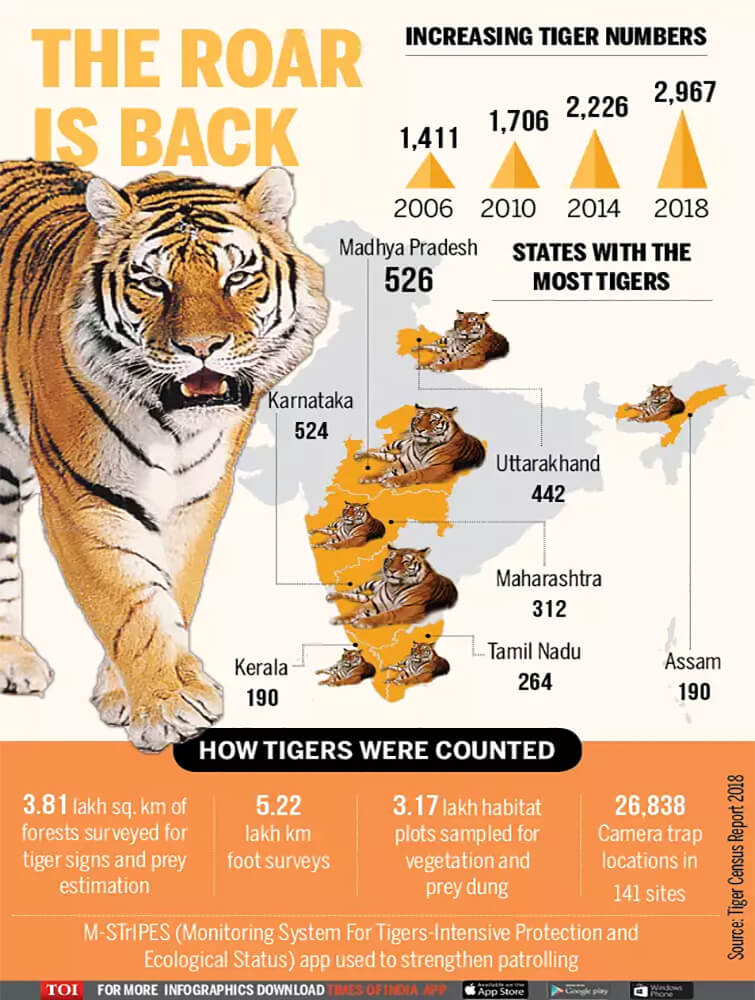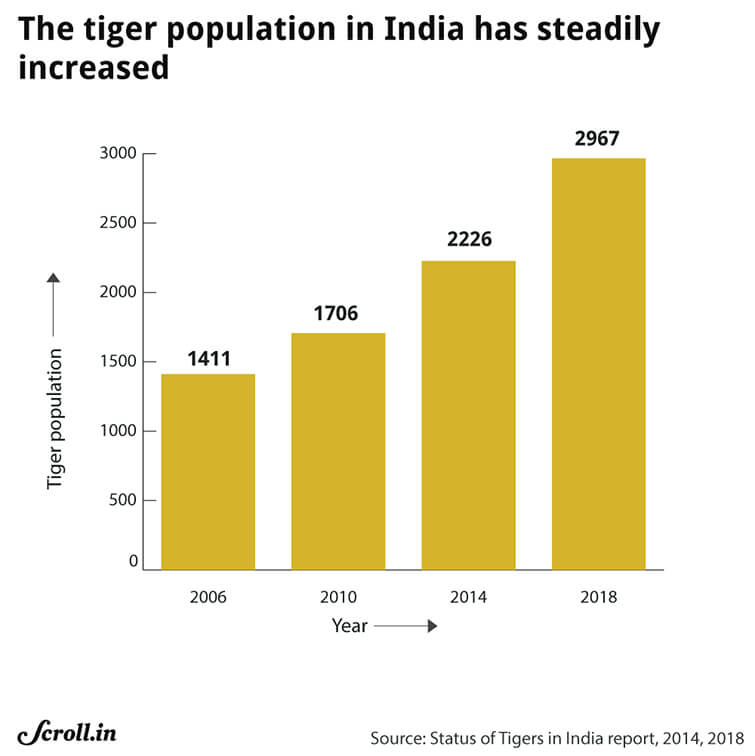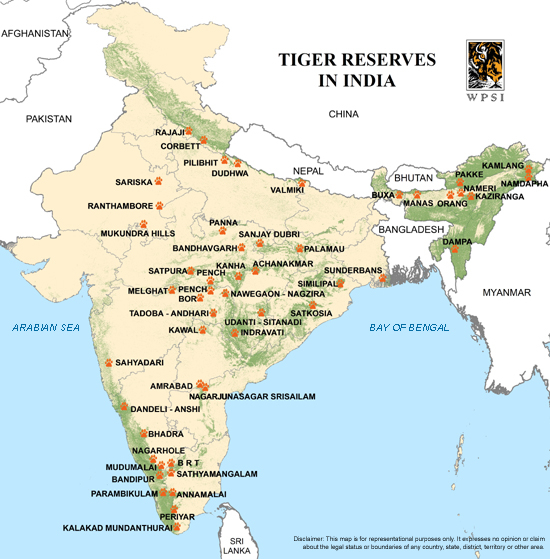Contents
- Tiger Census: Global Tiger Day
- India Report- Digital Education June 2020
TIGER CENSUS: GLOBAL TIGER DAY
Focus: GS-III Environment and Ecology, Prelims
Why in news?
- The Union Environment Minister released the detailed report of Tiger Census on the eve of Global Tiger Day.
- India has 30,000 elephants 3,000 one-horned rhinos, around 3,000 Tigers and more than 500 lions with a large amount of flora and fauna (8% of the world`s biodiversity) which makes it one of the soft powers of our country.
India’s Tiger Census of 2018: Highlights


- India’s Tiger Census of 2018 has made it to the Guinness Book of World Records, for being the world’s largest wildlife survey that has been captured via camera.
As per the survey, the country was home to an estimated 2967 tigers, which accounted to nearly 75 per cent of the global population. - India has 50 tiger reserves and none of them are poor quality.
Madhya Pradesh has the highest number of Tigers, with Karnataka following closely behind. (MP overtook Karnataka this time).
- No tigers were recorded in Mizoram’s Dampa and West Bengal’s Buxa tiger reserves while they face the severe threat of local extinction in Jharkhand’s Palamau reserve.
- Corbett Tiger Reserve, which is among reserves at or nearing capacity, had the largest population of tigers—about 231—in 2018.
- One in every three tigers in India lives outside reserves – according to the report, highlighting the challenge of protecting India’s national animal and reducing instances of man-animal conflict.
- The largest contiguous tiger population in the world—about 724—was found in the Western Ghats (Nagarhole-Bandipur-Wayanad-MudumalaiSatyamangalam-BRT block).
- Corbett, Kaziranga, Nagarhole, Ranthambore are among tiger reserves at or nearing capacity.
Tiger Census in India
- Every 4 years the National Tiger Conservation Authority (NTCA) conducts a tiger census across India.
- The first was conducted in 2006, followed by 2010 and in 2014.
- The Census (2014) had reported 2,226 tigers in the country, up from 1,706 in 2010.
- The fourth tiger census (All India Tiger Estimation 2018-19) estimated to be released in May 2019.
- This 2018 tiger census uses a mobile app named “MSTrIPES” for the very first time to store information of the counting.
- One of the Primary focus of the tiger census 2018 is to cover the northeast India that was not included in the previous census.
- For the very first time three neighbouring countries Bhutan, Nepal and Bangladesh are helping in counting the number of tigers all across India, especially in the region with mutual borders.
Global Tiger Day
- Global Tiger Day, often called International Tiger Day, is an annual celebration to raise awareness for tiger conservation, held annually on 29 July.
- It was created in 2010 at the Saint Petersburg Tiger Summit.
- The goal of the day is to promote a global system for protecting the natural habitats of tigers and to raise public awareness and support for tiger conservation issues.
Project Tiger
- Project Tiger is a tiger conservation programme launched in April 1973 by the Government of India.
- The project aims at ensuring a viable population of Bengal tigers in their natural habitats, protecting them from extinction, and preserving areas of biological importance as a natural heritage forever represented as close as possible the diversity of ecosystems across the distribution of tigers in the country.
- The project’s task force visualized these tiger reserves as breeding nuclei, from which surplus animals would migrate to adjacent forests. Funds and commitment were mastered to support the intensive program of habitat protection and rehabilitation under the project.
- The government has set up a Tiger Protection Force to combat poachers and funded relocation of villagers to minimize human-tiger conflicts.
Project Tiger’s main aims are to:
- Reduce factors that lead to the depletion of tiger habitats and to mitigate them by suitable management. The damages done to the habitat shall be rectified so to facilitate the recovery of the ecosystem to the maximum possible extent.
- Ensure a viable tiger population for economic, scientific, cultural, aesthetic and ecological values.
Project Tiger Reserves of India
The Project Tiger Reserves of India is administered by the National Tiger Conservation Authority.
| Project Tiger Reserves | Located State |
| Nagarjunsagar-Srisailam Kawal | Andhra Pradesh |
| Namdapha Pakhui/Pakke | Arunachal Pradesh |
| Kaziranga Manas Nameri | Assam |
| Valmiki Nagar | Bihar |
| Achanakmar Indravati Udanti and Sitanadi | Chhattisgarh |
| Palamau | Jharkhand |
| Bandipur Bhadra Dandeli-Anshi Nagarhole B.R Hills | Karnataka |
| Parambikulam Periyar | Kerala |
| Bandhavgarh Kanha Panna Pench Sanjay Dubri Satpura | Madhya Pradesh |
| Melghat Pench ShahyadriTabola-Andhari | Maharashtra |
| Dampa | Mizoram |
| Satkosia Simplipal | Orissa |
| Mukunda Hills Sariska Ranthambore | Rajasthan |
| Annamalai Kalakad-Mundathurai Mudumalai Sathyamangalam | Tamil Nadu |
| Katerniaghat Extension Dudhwa | Uttar Pradesh |
| Corbett | Uttarakhand |
| Buxa Sunderban | West Bengal |

INDIA REPORT- DIGITAL EDUCATION JUNE 2020
Focus: GS-II Social Justice
Why in news?
Union Minister for HRD virtually launched India Report on Digital Education, 2020.
India Report on Digital Education, 2020
Introduction
- The report elaborates on the innovative methods adopted by Ministry of HRD, Education Departments of States and Union Territories for ensuring accessible and inclusive education to children at home and reducing learning gaps.
- This report gives a better understanding of the various initiatives taken to facilitate remote learning and education for all by taking schools to the students.
- The quality digital education has acquired a new urgency in the present context of globalization, and the pandemic as well.
Highlights (Central)
- Ministry of Human Resource Development has initiated many projects to assist teachers, scholars and students in their pursuit of learning like DIKSHA platform, Swayam Prabha TV Channel, Online MOOC courses, On Air – Shiksha Vani, DAISY by NIOS for differently-abled, e-PathShala, National Repository of Open Educational Resources (NROER) to develop e-content and energized books, telecast through TV channels, E-learning portals , webinars, chat groups, distribution of books and other digital initiatives along with State/ UT Governments.
- Some of the major medium to connect to the students were using social media tools like WhatsApp Group for all the classes, Online classes through YouTube channel, Google meet, Skype etc., E-learning portal, TV (Doordarshan & regional channels), Radio (AIR), use of Diksha was most prominent choice of all the stakeholders.
Highlights (States)
- Some states have launched innovative mobile apps and portals as means to facilitate remote learning.
- Many states have had to be creative with low tech forms of teaching and instruction delivery with low or nil requirements of the internet. For instance- In Arunachal Pradesh, primary class students are receiving interesting Radio talks in their mother tongue through All India Radio.
- Andhra Pradesh has started Toll Free Call Centre and Toll Free Video call centre for students for understanding critical topics and clearing their doubts.
- Due to poor mobile connectivity and unavailability of internet services, Chhattisgarh has started Motor iskool.
- Some of the major digital initiatives by State Governments are SMILE (Social Media Interface for Learning Engagement) in Rajasthan, Project Home Classes in Jammu, Padhai Tunhar duvaar (Education at your doorstep) in Chhattisgarh, Unnayan Initiatives in Bihar through portal and mobile application, Mission Buniyaad in NCT of Delhi, Kerala’s own educational TV channel (Hi-Tech school programme), E-scholar portal as well as free online courses for teachers in Meghalaya.
Major Initiatives under National Mission on Education through Information and Communication Technology (NMEICT)
- SWAYAM: The Study Webs of Active Learning for Young Aspiring Minds’ (SWAYAM) is an integrated platform for offering online courses, covering school (9th to 12th) to Postgraduate Level. The online courses are being used not only by the students but also by the teachers and non-student learners, in the form of lifelong learning.
- SWAYAM Prabha: It is an initiative to provide 32 High Quality Educational Channels through DTH (Direct to Home) across the length and breadth of the country on a 24X7 basis.
- National Digital Library of India (NDL): It is a project to develop a framework of virtual repository of learning resources with a single-window search facility. Presently, there are more than 3 crore digital resources available through the NDL.
- Spoken Tutorial: They are 10-minute long, audio-video tutorial, on open source software, to improve employment potential of students. It is created for self learning, audio dubbed into 22 languages and with the availability of online version.
- Free and Open Source Software for Education (FOSSEE): It is a project promoting the use of open source software in educational institutions. It does that through instructional material, such as spoken tutorials, documentation, such as textbook companions, awareness programmes, such as conferences, training workshops, and internships.
- Virtual Lab: This is a project to develop a fully interactive simulation environment to perform experiments, collect data, and answer questions to assess the understanding of the knowledge acquired. There are about 225 such labs operational, with more than 1800 experiments that benefitted more than 15 lakhs students.
- E-Yantra: It is a project for enabling effective education across engineering colleges in India on embedded systems and robotics. More than 275 colleges across India have benefited with this initiative.



